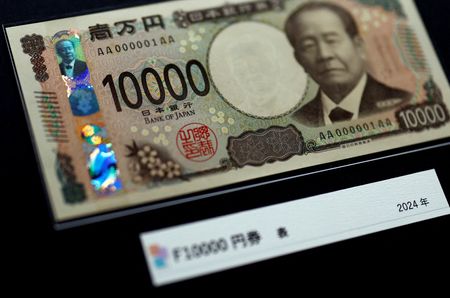By Vidya Ranganathan
SINGAPORE (Reuters) – Japan’s yen hit mid-January highs against the dollar at Asia open on Monday, as markets extended moves triggered last week after weak U.S. labour data stoked recession worries and expectations of deeper rate cuts by the Fed.
Friday’s job data, coming on top of a string of weak earnings reports from large technology firms and heightened concerns over the Chinese economy, drove a global selloff in stock markets, oil and high-yielding currencies as investors sought the safety of cash.
The selling continued on Monday, with U.S. Treasury yields falling further, stock indexes in the red and currencies slightly less volatile but down against the dollar and yen.
The safe-haven and carry-funding favourite, the yen, was traded at 145.43 yen, up 0.8% versus the dollar, after hitting a mid-January peak of 145.28 in early deals.
The euro was flat at $1.091, the dollar index was nearly flat too at 103.17 while the Australian dollar fetched $0.6495 and was down 0.25%.
“The market pricing has a 50 basis point rate cut by the Fed at its September meeting, which I think will be too much,” said Masafumi Yamamoto, chief currency strategist at Mizuho Securities in Tokyo.
“The U.S. economy is showing signs of slowdown but it’s not as bad as the market is pricing in.”
But near-term momentum could keep the selloff going, with technical levels also pointing to more yen gains, he said.
Treasury yields have been falling quite sharply since last week, when the Federal Reserve kept the policy rate in its current 5.25% to 5.50% range while Chair Jerome Powell opened the possibility of a rate cut in September.
But by Friday, after data showed the unemployment rate jumped, sparking chatter U.S. economy could be heading for a recession, expectations for rate cuts deepened.
Yields on 10-year U.S. Treasuries sank nearly 40 basis points last week, the largest weekly fall since March 2020, and were last at 3.79%.
Fed fund futures reflected traders pricing an over 70% chance of a 50 basis point cut at the central bank’s September meeting, according to CME FedWatch. Futures imply 155 basis points of cuts this year, with a similar amount in 2025.
The yen is up 10% against the dollar in just over 3 weeks, driven in part of the Bank of Japan’s large 15 basis points rate rise last week to 0.25%, alongside which it announced a plan to halve its monthly bond purchases over the next couple of years.
Barclays analysts said the Japanese currency was the most overbought among G10 majors and therefore “the bar for yet more outperformance in the near term appears high”.
The two-day rout in stock markets late last week saw the tech-heavy Nasdaq Composite notch a 10% correction from a record high hit in early 2022. Equities plunged in Europe and Asia as well, with Japan’s Nikkei index losing nearly 5% for the week.
The closely watched U.S. two-year-to-10-year yield curve narrowed its inversion, to minus 5.7 bps, the least inverted since July 2022, reflecting both recession fears and expectations for sharp easing of short-term yields.
Meanwhile, markets are also dealing with the risk of military escalation in the Middle East after latest developments in the war between Israel and Hamas in Gaza, which has driven oil prices to January lows.
The U.S. military is deploying more forces in the Middle East and Europe following threats from Iran and its allies Hamas and Hezbollah to respond to the killing of Hamas leader Ismail Haniyeh two days ago in Tehran.
(Reporting by Vidya Ranganathan; Editing by Christopher Cushing)





